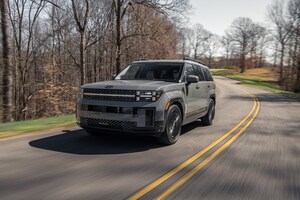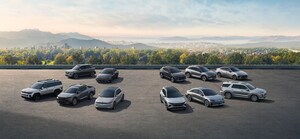WASHINGTON, Feb. 14, 2011 /PRNewswire/ -- Hyundai Motor America continues its commitment to fuel economy leadership and alternative fuel technology with the introduction of the next-generation hydrogen fuel cell vehicle, the Tucson ix Fuel Cell Electric Vehicle (FCEV). The Tucson ix FCEV makes its U.S. public debut at Fuel Cell & Hydrogen Energy 2011 in Washington, DC and will be on display Feb. 14-16.
(Logo: http://photos.prnewswire.com/prnh/20091001/HYUNDAILOGO)
"We are excited to share the latest in Hyundai's fuel cell technology," said Dr. Tae Won Lim, Managing Director of Hyundai Motor Company's Fuel Cell Vehicle Group. "After several years of testing, we have identified ways to maximize fuel efficiency without compromising driving experience and powertrain range. We hope to continue this momentum in finding ways to better fuel cell technology and performance."
Hyundai's third-generation FCEV is equipped with its newest 100-kilowatt fuel cell system and two hydrogen storage cylinders (700bar) to deliver a substantial improvement in fuel efficiency. The Tucson ix FCEV can travel more than 400 miles on a single fueling, a 76-percent improvement over its predecessor, and a range equal to a gasoline-powered car. It achieves gasoline equivalent fuel efficiency of more than 70 miles per gallon, a 15-percent improvement over the previous version. It can also start in temperatures as low as minus 25 degrees Celsius.
In addition to improving the fuel economy and range of the powertrain, Hyundai has also created a more compact power source for the Tucson ix FCEV. Overall volume of the fuel cell system was downsized by 20-percent compared to the previous system via modularization of bulky parts in the fuel cell system including fuel cell stack, balance of plant (BOP), inverter and high voltage junction box.
Hyundai will test about 50 new Tucson ix FCEVs throughout 2011 as part of the second phase of the Korean Government Validation Program. Hyundai plans to make a limited supply of the Tucson ix FCEV in 2012 and begin mass production in 2015.
Comparison of new Tucson ix FCEV (3rd generation) and Tucson FCEV (2nd generation)
CLASSIFICATION |
Tucson ix |
Tucson |
||
SPECIFICATIONS |
Fuel Cell Stack |
100kW |
100kW |
|
Drive System |
100kW |
100kW |
||
Energy Storage System |
21kW |
100kW |
||
Hydrogen Storage System |
700bar (Hydrogen : 5.6kg) |
350bar (Hydrogen : 3.5kg) |
||
PERFORMANCE |
Maximum Speed |
100 mph |
100 mph |
|
Gasoline Equivalent Fuel Efficiency |
72 mpg |
63 mpg |
||
Max. Driving Distance per single refueling |
403 mi |
230 mi |
||
"The Tucson ix FCEV shows that Hyundai is taking a multi-faceted approach to improving fuel economy, developing hydrogen fuel cell vehicles along with its patented Blue Drive technology," said John Juriga, Powertrain Director at Hyundai Kia America Technical Center, Inc. "Hyundai is committed to developing a diverse portfolio of fuel efficient options for our customers, as seen with our Sonata Hybrid, turbocharged Gasoline Direct Injection (GDI) engine and the all-new 1.8-liter Nu engine delivering 40 mpg highway for the Elantra. The introduction of the new FCEV is just another example of all the things we're doing to increase the ecological friendliness and the fuel economy of our products."
HYUNDAI MOTOR COMPANY
Established in 1967, Hyundai Motor Company has grown into the Hyundai Motor Group which has ranked as the world's fifth-largest automaker since 2007 and includes over two dozen auto-related subsidiaries and affiliates. Employing over 75,000 people worldwide, Hyundai Motor sold approximately 3.1 million vehicles globally in 2009, posting sales of US$41.8 billion (including overseas plants, using the average currency exchange rate of 1,276 won per US dollar). Hyundai vehicles are sold in 193 countries through some 6,000 dealerships and showrooms. Further information about Hyundai Motor and its products are available at www.hyundai.com.
SOURCE Hyundai Motor America
WANT YOUR COMPANY'S NEWS FEATURED ON PRNEWSWIRE.COM?
Newsrooms &
Influencers
Digital Media
Outlets
Journalists
Opted In






Share this article